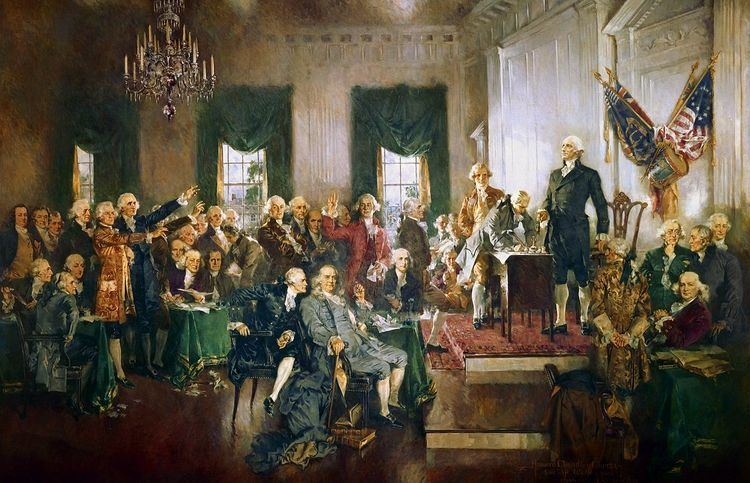A constitutional convention is a gathering for the purpose of writing a new constitution or revising an existing constitution. Members of a constitutional convention (sometimes referred to as "delegates to" a constitutional convention) are often elected by popular vote. The resulting constitutional frame of government is often subjected to a popular vote via referendum before it enters into force.
Examples of constitutional conventions to form or revise the constitution of a nation include:
United States
Annapolis Convention (1786), which proposed what became the Philadelphia Convention (1787).
Philadelphia Convention (1787), where the United States Constitution, was drafted before being ratified by all thirteen of the States in the original Union.
As to future amendments, two procedures are set out in Article V of the constitution, but only one has ever been used. The process begins with Congress, which by two-thirds majority votes of the Senate and House of Representatives may submit amendments to the states for ratification. Under the second, untried method, amendments may be proposed by a convention of the states <Smith v Union Bank of Georgetown 30US.518 1831>, which Congress must convene, if asked to do so by the legislatures of two-thirds of the states. Under either method, a proposed amendment becomes part of the Constitution if it is ratified by three-fourths of the states, through state legislatures or state ratifying conventions, whichever Congress chooses. So far, in all but one instance Congress has specified ratification by state legislatures. The convention route was used to ratify the Twenty-first Amendment in 1933.
France: The National Convention of 1792 (commonly referred to as The Convention) convened during The French Revolution on September 20 with the purpose of writing a Republican Constitution following the suspension of the French Monarchy. The monarchy was officially abolished on September 21 by The Convention.
Canada
Quebec Conference, 1864
London Conference of 1866.
Australia
1891
1897
1973
1998.
Germany: Parlamentarischer Rat (Parliamentary Council) (1948) – Drafted the Basic Law of the Federal Republic for ratification by the Länder.
Northern Ireland: Northern Ireland Constitutional Convention (1975–1976) – a failed attempt to find a solution to the status of Northern Ireland.
Scotland: Scottish Constitutional Convention (1989) – produced a plan for Scottish devolution.
European Union: European Convention (2001) – Drafted the Constitution for Europe for approval by the European Council and ratification by the member states.
Philippines
1898 - drafted the 1898 Malolos Constitution, the basic law of the First Philippine Republic, the very first constitutional republic in Asia. The drafted constitution was written by Felipe Calderón y Roca and Felipe Buencamino as an alternative to a pair of proposals to the Malolos Congress by Apolinario Mabini and Pedro Paterno. After a lengthy debate in the latter part of 1898, it was enacted on 21 January 1899.
1935 – to draft a constitution to create the autonomous Commonwealth of the Philippines under the U.S. Tydings–McDuffie Act. The constitution was also used in the 3rd Republic (1946) until the passage of the 1973 constitution. Members were elected through the Philippine Constitutional Convention election, 1934
1971 – to draft a revised constitution to replace the old U.S. customed 1935 Philippine constitution. Members were elected through the Philippine Constitutional Convention election, 1970. The system of government changed from Presidentitial to Parliamentary to Presidentital-Parliamentary (in 1984 amendment). The constitution lasted until the downfall of Ferdinand Marcos in 1986 and Corazon Aquino appointed members to draft the 1987 Constitution through a Constitutional Commission.
Ireland: In Ireland, the government elected in March 2011 has committed to establishing a "constitutional convention" to recommend constitutional amendments on six specified issues and others it may consider; the government has separately promised amendments on five other issues.
Constitutional conventions have also been used by constituent states of federations — such as the individual states of the United States — to create, replace, or revise their own constitutions. Several US States have held multiple conventions over the years to change their particular state's constitutions.
Missouri has held four, in 1820, 1865, 1875 and 1945.
Michigan has held four, in 1835, 1850, 1908 and 1963.
Massachusetts has held six, in 1778, 1779–80, 1820-21, 1853, 1917–18, and most recently 2016.
Virginia Conventions have included six unlimited meetings. Constitutions were promulgated by fiat in 1776, 1864 and 1901-02, and ratified by referendum in 1829-30, 1850, and 1868. Limited Conventions and Constitutional Commissions resulting in revisions were held in 1927, 1945, 1956 and 1968. Subsequently the state legislature proposes amendments that are ratified in popular referendum.

